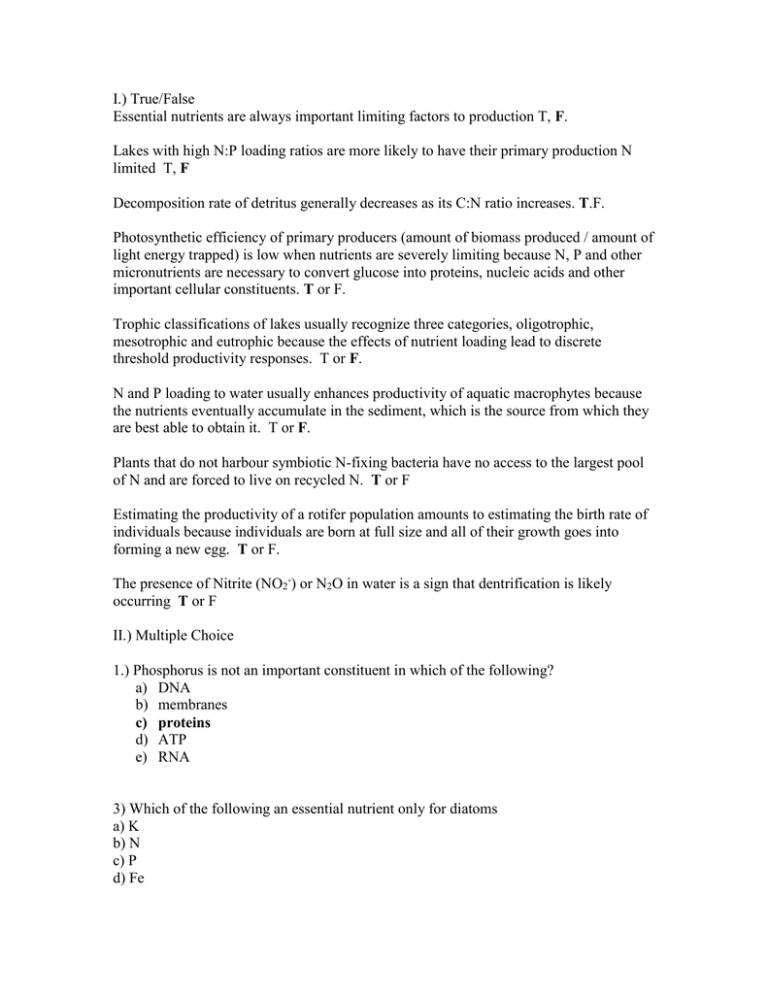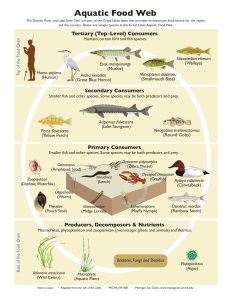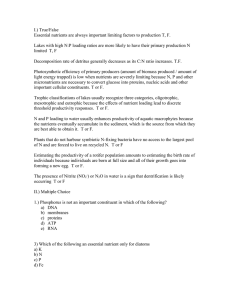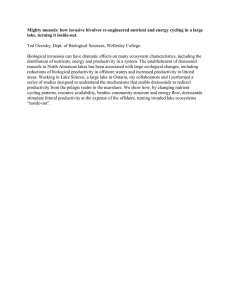I.) True/False F
advertisement

I.) True/False Essential nutrients are always important limiting factors to production T, F. Lakes with high N:P loading ratios are more likely to have their primary production N limited T, F Decomposition rate of detritus generally decreases as its C:N ratio increases. T.F. Photosynthetic efficiency of primary producers (amount of biomass produced / amount of light energy trapped) is low when nutrients are severely limiting because N, P and other micronutrients are necessary to convert glucose into proteins, nucleic acids and other important cellular constituents. T or F. Trophic classifications of lakes usually recognize three categories, oligotrophic, mesotrophic and eutrophic because the effects of nutrient loading lead to discrete threshold productivity responses. T or F. N and P loading to water usually enhances productivity of aquatic macrophytes because the nutrients eventually accumulate in the sediment, which is the source from which they are best able to obtain it. T or F. Plants that do not harbour symbiotic N-fixing bacteria have no access to the largest pool of N and are forced to live on recycled N. T or F Estimating the productivity of a rotifer population amounts to estimating the birth rate of individuals because individuals are born at full size and all of their growth goes into forming a new egg. T or F. The presence of Nitrite (NO2-) or N2O in water is a sign that dentrification is likely occurring T or F II.) Multiple Choice 1.) Phosphorus is not an important constituent in which of the following? a) DNA b) membranes c) proteins d) ATP e) RNA 3) Which of the following an essential nutrient only for diatoms a) K b) N c) P d) Fe e) Si 6.) Macrophytes and benthic algae generally outcompete phytoplankton in littoral regions of oligo- and mesotrophic lakes and rivers because a) they can outcompete phytoplankton for light b) they produce substances that are toxic to phytoplankton c) they are generally more limited by carbon than by N and P d) they can access N and P from sediments, which phytoplankton cannot e) they have very low nutrient requirements Correlational studies can sometimes provide a more accurate picture of the resource that is limiting to primary producers than experimental manipulations because a) experiments are often limited in duration by practical constraints and sometimes only tell us which nutrient is limiting on the short-term b) experiments often involve simplified treatments that isolate the primary producers from consumers which is a situation that doesn’t often occur in nature. c) While experiments can be conducted on a variety of spatial and temporal scales, they are usually conducted on smaller spatial scales than real systems operate, making the results an abstraction d) Many systems, eg large rivers are too spatially complex for clear-cut experimental treatments to be carried out. e) None of the above are true f) a, b, c and d are all true Schindler’s studies on whole lake systems in the Experimental Lakes area of western Ontario, were unique in that a) they were the first attempt to manipulate P, N and C simultaneously b) they completely controlled for all physical factors that could affect the primary productivity of the ecosystem c) they were thoroughly replicated and therefore very statistically conclusive d) they were the first attempt to manipulate the nutrient loading regime of a lake e) they were the first attempt to study whole lakes in a controlled experimental framework The Lake Washington “experiment” influenced our ideas about the functioning of lake ecosystems because by diverting sewage from the lake and monitoring the responses a) it showed that Phosphorus was a key limiting nutrient b) it showed that sewage input to a lake could grossly change the nature of the ecosystem c) it showed that environmental science could have a great impact on social decisions d) it showed that nutrient diversion always leads to significant improvements in water quality of a lake e) both b and c are true f) both a and b are true Which of the following is not a reason why nutrient diversions like the Lake Washington sewage diversion experiment don’t always lead to significant improvements in water quality. a) the lake in question may not be limited by any of the nutrients being diverted b) the internal nutrient load may be so great that the external load diversion may be a small fraction of the total load c) the water may be so turbid from clay or other sediment loading that the light regime is actually limiting to primary producers d) the water renewal rate may be so slow (water retention time so long) that it takes many years for a change in the nutrient loading regime to have a significant effect on the lakes nutrient concentration e) the non-point source loadings may be so large that the diversion may constitute a tiny fraction of the total nutrient load to the lake f) all of these reasons are reasonable possibilities. Trophic classifications are usually based on either the total Phosphorus content of the water or the concentrations of Chlorophyll a because a) P is the only important limiting nutrient that can determine the productivity of the primary producers b) This is a convient approach to classification that uses easily measured parameters. c) P and chlorophyll a are so well correlated that they always lead to the same trophic status determination. d) Lakes that are limited by other nutrients like, say N or Si are rare, are too rare or unimportant to worry about e) The effects of other limiting nutrients was not known at the time that the P-chl approach became popular. Phosphorus loading models have become very popular in lake management because a) everybody can afford a computer and its cheaper and safer to model lakes from your office than to go out and make measurements b) These models force one to think systematically about how the system works and tend to focus measurements down productive channels c) Measurements are more likely to be wrong than model predictions d) Loading models can predict the responses to planned manipulations of the landscape or changes in effluent treatments, and predict the likelihood that planned interventions will lead to water quality improvements e) b and d are both true. Assuming that a lake has a P budget that is in equilibrium and follows the equation P* I R I R . The total P concentration is 60 mg/m3, the lake has an area V h ksed Qo Vksed of 10 km2 and a mean depth of 10 m. The annual P load from external sources is 6000 kg , the ksed is 0.5/yr, and the water discharge from the lake is 5 x 107 m3/yr. The lake managers predict that a reduction of the annual external load to 3000 kg will bring about a decline in total P concentration to 30 mg/m3. There prediction will only be correct if a) b) c) d) e) the lake remains unstratified the water residence time is 2 years there is no internal P loading from the sediment there is no dam or wier on the outflow the answer could never be correct Aquatic macrophyte communties more often exhibit a negative rather than a positive growth response to N and P loading because a) nutrient loading does not usually add significant quantities of nutrient to the mud, which is the source that macrophytes utilize b) N and P loading usually enhances phytoplankton growth which reduces the light penetration to the sediment c) Macrophytes are more often limited by dissolved inorganic carbon in water than by N or P. d) a, b and c are all true e) None of these are true Two species of aquatic macrophytes are growing in water containing dissolved CO2 and HCO3-. Species 1 grows outgrows Species 2 when the pH is low (<7) whereas when the pH is high (>8) Species 2 outgrows 1. This most likely indicates that a) Species 1 utilizes dissolved CO2 more effectively than Species 2 b) Species 2 utilizes bicarbonate more effectively than Species 1 c) Species 2 likley employes carbonic anhydrase in accessing its carbon source d) Both a and b are true e) a, b and c are all true Aquatic ecosystems with hard waters, such as those found in Alberta generally have more aquatic macrophyte biomass and diversity because a) hard waters will contain a larger quantity of dissolved inorganic carbon which is the main resource that usually limits their productivity b) aquatic macrophytes require a great deal of calcium c) hard waters usually are very clear and have good light penetration to the substrate d) hard waters generally have more dissolved N and P than soft waters e) a, b, c and d are all true. Methane concentrations are usually very low in surface waters of lakes because a) methanogens are inhibited by light b) methane is a gas and tends to bubble out of the lake c) methanogens require H2 which is only found under reducing conditions d) methanogens are chemolithotrophs and require an inorganic energy source e) all of the above are true. Fats liberate more energy per g, then carbohydrates do because a) they have less oxygen atoms in their molecules than C atoms b) the oxidation state of their C atoms is lower than that of sugars c) each atom of C in a lipid liberates 6 electrons, whereas each C atom in a carbohydrate liberates only 4 d) a and b are true e) a, b and c are all true Rank the following carbon compounds from most reduced to most oxidized (lowest to highest oxidation states of C): methane (CH4), Acetic acid (CH3COOH), bicarbonate (HCO3- ), and ethanol (C2H5OH). a) methane, bicarbonate, acetic acid and ethanol b) methane, ethanol, acetic acid and bicarbonate c) bicarbonate, ethanol, acetic acid and methane d) methane, acetic acid, ethanol and bicarbonate e) methane, acetic acid, bicarbonate and ethanol Thiobacillus, bacteria that obtain energy by oxidizing iron pyrites and other reduced sulfur compounds to liberate sulphite, sulphate, dissolved iron and other metals and free protons are considered a) chemoheterotrophs b) photoheterotrophs c) photoautotrophs d) chemoautotrophs e) none of these Halophiles, archaeans that live in highly saline lakes and utilize rhodopsin pigments to generate ATP from light allowing them to build their biomass from simple organic compounds are considered. a) chemoheterotrophs b) photoheterotrophs c) photoautotrophs d) chemoautotroph e) a none of these Pseudomonas, bacteria that obtain their energy by oxidizing organic compounds using Nitrate as an electron acceptor are considered a) chemoheterotrophs b) photoheterotrophs c) photoautotrophs d) chemoautotroph e) a none of these The leaves of the aquatic fern Azolla, have sinuses inside which they harbour the cyanobacteria Anabaena azollae. This relationship is advantageous to the fern because a) the Anabaena liberates P which the fern requires b) the Anabaena are photoautotrophs that have heterocyst cells that fix N2 into ammonia, which leaks into the surrounding water c) the Anabaena are parasitic and don’t benefit the fern d) the Anabaena fix N and produce toxic N compounds which inhibit other plants e) none of these are true The form of N that can be used by plants with the minimum cost is a) NH3 or NH4+ b) NO3c) N2 d) free amino acids in the sediment e) NO2- Sewage treatment methods aimed at releasing low N sewage back into receiving waters should try to modify the treatment process to a) stimulate the growth of Nitrosomonas bacteria b) try to keep the oxygen level within the range most conducive to Nitrate reducing bacteria c) stimulate the growth of N-fixing cyanobacteria d) stimulate the growth of ammonifying bacteria in the treatment e) none of these Lakes with high N:P ratios in their nutrient loads are a) likely to have their algal communities become P-limited rather than Nlimited b) unlikely to have their algal communities dominated by Aphanizomenon or Anabaena c) likely to have their algal communities dominated by toxic cyanobacteria d) likely to have high dentrification rates e) all of these are true Lakes with high human populations in their watersheds are likely to a) be very eutrophic b) have high dentrification rates c) have high ammonia levels in their deeper waters d) high nitrate levels e) all of these are true Mine tailings exposed to air are likely to make the surface waters very a) anoxic b) metal rich c) sulfate rich d) acidic e) a and b are true f) b, c and d are all true The density of a rotifer population is 600/L and two-thirds are carrying eggs. On average it takes 4 days for an egg to hatch. The birth rate of the population is a) 50 per day per L b) 100 per day per L c) 1/6 per individual per day d) 500 per day per L e) Both b and c are true If the above Rotifer population is growing at the rate of 1/10 per day per individual what is the per captita death rate a) 0.067 /d b) 0.67/d c) 0.1/d d) 0.01/d e) None of the above In a pike population the weight at the end of year 2 is 200 g, and the weight at the end of year 1 is 50 g. The SGR for 1 year old is a) 1.386 g/g/yr b) 0.138 g/g/yr c) 4 g/g/yr d) Ln 4 g/g/yr e) Both a and d are true In a pike population the weight at the end of year 2 is 200 g, and the weight at the end of year 1 is 50 g. If the biomass of pike in the one-year old age group is 10 kg/ha, the productivity of this age class is a) 13.86 kg/ha/yr b) c) d) e) 1.386 kg/ha/yr 40 kg /ha/yr (Ln 4 * 10) kg /ha/yr Both a and d are true If the productivity of a phytoplankton population is 6000 k J (kilo Joules) /yr per m2, If sedimentation rate of dead cells to the substrate constitutes 2000 kJ/m2yr, and the phytoplankton population is dB/dt=0. If the rain of zooplankton fecal pellets to the bottom is 2400 kJ/m2/yr. What is the assimilation efficiency of the zooplankton trophic level (assume that they are all feeding on phytoplankton). a) b) c) d) e) 0.40 or 40% 0.60 or 60% 0.35 or 35% 0.25 or 25% None of these What is the exploitation efficiency EE (or Consumption efficiency CE) of the zooplankton trophic level a) 0.42 or 42% b) 0.67 or 67% c) 0.35 or 35% d) 0.25 or 25% e) None of these If the net production efficiency of the zooplankton trophic level is 0.40 (40%) what is the ecological efficiency () of the trophic level a) 0.15 or 15% b) 0.05 or 5% c) 0.11 or 11% d) 0.25 or 25% e) None of these If the zooplanktivorous fish are consuming zooplankton at the rate of 500 kJ/yr, their EE (CE) is a) b) c) d) e) 0.40 or 40% 0.78 or 78% 1.00 or 100% 0.25 or 25% None of these If the zooplanktivorous fish have an assimilation efficiency of 0.70 (70%) and Net production efficiency (NPE) of 0.20 (20%), the productivity at this trophic level is a) 90 kJ/yr b) 70 kJ/yr c) 100 kJ/yr d) 280 kJ/yr e) None of these Multiple Choice While the dry matter content of detritus tends to decrease over time, the protein content usually increases to a maximum before declining. This reason for this pattern is that a) proteins are more difficult for animal detritivores to attack b) microbes (bacteria and fungi) have a higher protein content than the un conditioned plant matter and become an increasingly large fraction of the detrital mass during the decay process, but then tend to be selectively eaten by animal detritivores. c) carbohydrate and lipid material are converted into protein during the decay process, which are then selectively eaten by detritivorous animals. d) Both a and b are correct e) Both b and c are correct Detritivorous animals stimulate the breakdown of detritus even though their contribution to total respiration is low. The reason for this is a) breakdown of most detritus is anaerobic and is carried by methanogens b) animals have much lower metabolic rates than microbes like bacteria and fungi c) the animals tend to break down intact detritus into small particles which are in turn more readily decomposed by bacteria and fungi. d) Animal metabolism raises the temperature which allows the bacteria and fungi to decay detritus more rapidly e) both a and b are correct dB rB (b m) B , describes the rate of change of B (biomass of a dt population) with time, as a function of birth/growth (b) and mortality (m) processes. This equation describes what type of growth process a) exponential growth or decay b) sigmoidal growth process where B approaches a carrying capacity c) geometric growth d) a process where the per capita birth and death rates are independent of the population biomass The equation e) both a and d are correct In a population where per capita birth rate decreases and per capital death rate increases with increasing B, there will be a value of B where the two lines intersect. When B exceeds this value a) the population has reached the inflection point (i) b) The population has reached r0 c) the population has reached its maximum sustainable yield (MSY) d) the population will decline e) per capita death rate will exceed per capita birth f) both d and e are true. dB B r 0 B 1 , where dt K r0=the intrinsic rate of increase, and K is its carrying capacity. If such a population is at its carrying capacity and exploited at the rate C. Its B will a) remain constant b) change at the rate r0 r0K c) approach 4 d) approach K/2 e) decline f) increase For a population whose biomass (B) follows the growth curve Sunfish have a deep-bodied (“panfish”) form that has been interpreted as an adaptive response for defense against gape-limited predators. The cost of this adaptation is likely a) reduced swimming speed is as a result of increased intertial drag b) the large dorsal and anal spines, and their supporting skeletal elements, are likely energetically costly c) the body is likely not flexible enough to generate much muscular propulsive force. d) Both a and b are likely true e) a, b, and c are all likely true. Bythotrephes is a large carnivorous zooplankter that has recently invaded North America. Zooplanktivorous fish at first eat it, but the large tail spine, which can puncture the stomach, or at least fill it up with non-digestible spines that tend to stay there, create large problems. Some studies show that fish do “learn” to avoid eating them. This is actually a very ecologically costly solution because a) Bythotrephes is a competitor with these fish, and not eating them just strengthens their competitive position b) not eating them just allows them to become more abundant c) fish have to expend time and effort to distinguish Bythotrephes from palatable zooplankton d) a, b, and c are all likely to be true e) not eating them seems a reasonably efficient solution. While zooplankton evolve vertical migration patterns as a defensive response against predators, these responses are costly because a) it requires a lot of effort for a tiny animal to move up and down several 10’s of meters every day b) moving down during the day, can put them into colder water with much less phytoplankton for them to feed on c) being able to feed in the more productive surface waters only during the night, will sharply reduce their productivity d) a, b, and c are all likely to be true e) none of these are likely true.








